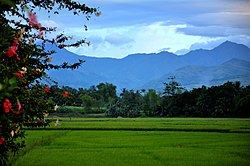Isabela | |
|---|---|
| Municipality of Isabela | |
 Barangay Camangcamang with Mabinay Mountains seen in the distance | |
| Nickname: The Sweet Heart of Negros | |
 Map of Negros Occidental with Isabela highlighted | |
Location within the Philippines | |
| Coordinates: 10°12′N122°59′E / 10.2°N 122.98°E | |
| Country | Philippines |
| Region | Negros Island Region |
| Province | Negros Occidental |
| District | 5th district |
| Named after | Isabella II of Spain |
| Barangays | 30 (see Barangays) |
| Government | |
| • Type | Sangguniang Bayan |
| • Mayor | Miguel Angelo G. Yulo (Lakas) |
| • Vice Mayor | Renato M. Malabor, Jr. (Lakas) |
| • Representative | Emilio Bernardino L. Yulo III (Lakas) |
| • Municipal Council | Members |
| • Electorate | 42,760 voters (2025) |
| Area | |
• Total | 178.76 km2 (69.02 sq mi) |
| Elevation | 52 m (171 ft) |
| Highest elevation | 651 m (2,136 ft) |
| Lowest elevation | 12 m (39 ft) |
| Population (2024 census) [3] | |
• Total | 65,399 |
| • Density | 365.85/km2 (947.54/sq mi) |
| • Households | 15,685 |
| Economy | |
| • Income class | 1st municipal income class |
| • Poverty incidence | 23.96 |
| • Revenue | ₱ 285.9 million (2022) |
| • Assets | ₱ 473.8 million (2022) |
| • Expenditure | ₱ 228 million (2022) |
| • Liabilities | ₱ 86.09 million (2022) |
| Service provider | |
| • Electricity | Negros Occidental Electric Cooperative (NOCECO) |
| Time zone | UTC+8 (PST) |
| ZIP code | 6128 |
| PSGC | |
| IDD : area code | +63 (0)34 |
| Native languages | Hiligaynon Ati Tagalog |
| Website | www |
Isabela, officially the Municipality of Isabela, is a municipality in the province of Negros Occidental, Philippines. According to the 2024 census, it has a population of 65,399 people. [5]
Contents
- History
- Geography
- Barangays
- Climate
- Demographics
- Economy
- Festival
- Notable personalities
- References
- External links
It is known for BISCOM (Binalbagan Isabela Sugar Company) located in nearby Binalbagan town.



